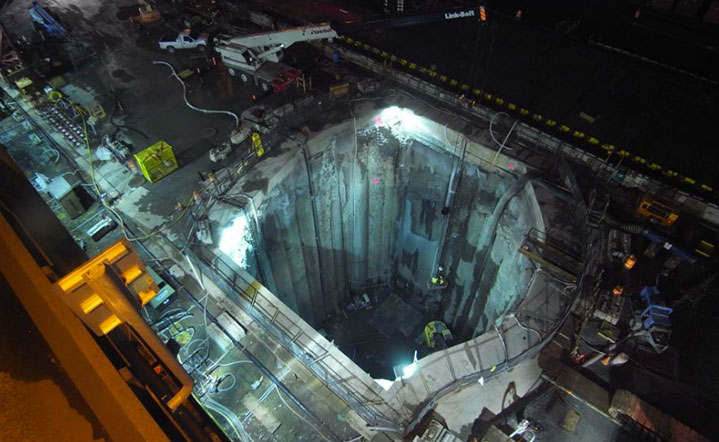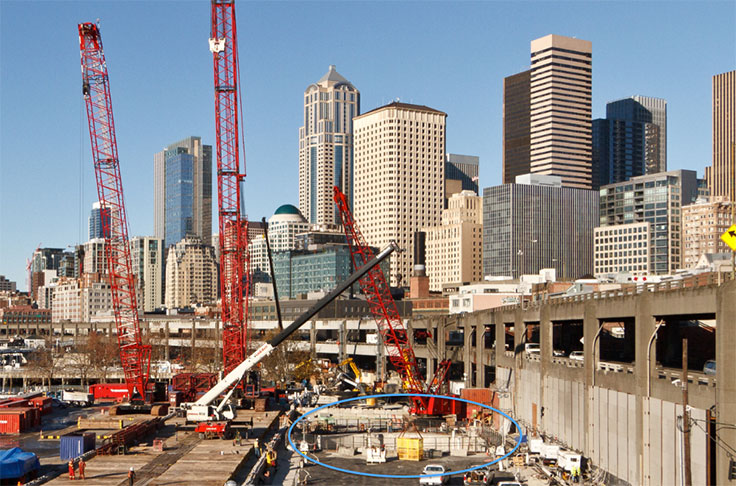Seattle TBM recovery shaft repair row 12 Jan 2015
WSDOT officials were summoned to Seattle City Hall Monday (January 12) to give a full and public explanation of an internal memo that apparently warned of “the risk of a catastrophic failure” of the three-fourths completed recovery shaft that is currently being excavated just 20ft away from the SR99 viaduct.
An alarming summary of the memo – originally penned on December 11 by tunnel contractor Seattle Tunnel Partners’ (STP) appointed Engineer of Record, Brierley Associates – caused widespread panic in Seattle after the City’s transportation department (SDOT) released a highly edited version of the eight-page memo which appeared to suggest that the recovery shaft might be in danger of imminent collapse.
As a result, three of WSDOT’s most senior officials – Matt Preedy, Todd Trepanier and David Sowers – were called to City Hall to explain the situation before the full council. At the meeting it transpired that SDOT officials had accessed the contentious December 11 memo at the end of last week from a password-protected computer database of project correspondence that WSDOT makes available to partner organizations.
Recovery shaft repairs
Matt Preedy of WSDOT explains complications arising from the need to grout voids between STP’s advance underground settlement mitigation wall (built to protect the viaduct foundations from the early stages of the TBM drive) and the piles that form the compression ring walls of the recovery shaft (Fig 1). Pre-excavation grouting has not been 100% successful, and the contractor – following advice from designer Brierley Associates – is now adopting jet grouting ahead of excavation of each ‘lift’ now that the depth has reached 90ft and subject to increased pressures. Previously it had been applying grout to untreated soil zone areas after each excavation lift.
WSDOT is now accusing SDOT of “misrepresentation” of the facts of the case and of taking the relevant passage of the memo “out of context”. It is now threatening to cut off all password access to the database to prevent further “misunderstandings”. Todd Trepanier told the council meeting that the December 11 warning came from a draft memo; that the words “catastrophic failure” were never intended to refer to the current situation but rather represented a risk assessment of what might happen if a new jet grouting methodology was not adopted for the last 30ft of excavation; and that the draft was superseded by a more measured memo dated December 19.
However, members of the council – who had only seen a summary version of the actual December 11 memo going into Monday’s meeting – remained unconvinced. “This is an engineers’ report. I used to be an engineer and they are not given to hyperbole, so when one says ‘catastophic failure’ it has to mean something of importance to the public,” said Cllr Kshama Sawant.
“I remain very concerned about the safety of the viaduct, and the fact that the viaduct is less than 20ft from this 90ft deep pit and remained open while there were engineers saying that there is the possibility of ‘catastrophic failure’, and that somehow digging down to 90ft provided no risk but going to 91 held the potential for ‘catastrophic failure’ … raises some serious concerns for me,” said Cllr Mike O’Brien.
The row centers on the design and excavation of the 120ft deep x 80ft diameter recovery shaft that is being excavated by STP subcontractor Malcolm in front of stricken TBM Bertha’s cutterhead. Once the shaft is completed the 17.48m diameter machine will be driven through to enable access to its compromised seal and bearing systems.
The original December 11 memo broadly coincides with a period, starting December 12, when shaft construction work was stopped by WSDOT for four days. Ground settlement of up to 1.4in in the vicinity of the excavation works (Fig 2) had prompted a series of investigations of nearby buildings and structures, including the viaduct itself. With extensive dewatering having taken place at the site as part of the shaft excavation process, WSDOT ordered a stop to works to give STP and its Engineer of Record (Brierley Associates) time to devise a mitigation plan.
Todd Trepanier ‘catastophic failure’ explanation
By December 16 this had been satisfactorily submitted to WSDOT and work at the recovery shaft was able to restart. Todd Trepanier explained that the WSDOT stop order on December 12 “had nothing to do with the stuctural integrity of the pit.”
He said: “It had to do with two issues – first, the settlement issues that we were all trying to coordinate. There was some assocation with the deep well pumping operations that may have contributed to the settlement, and so what we were interested in knowing was could the contractor have a method to protect the shaft in case they had to shut off those deep wells. So we asked the contractor to supply us with a process as to how they would be able to do that and not jeopardize the work that had been completed.”
He went on: “Second, we wanted a few more days to assess the data on how settlement had stabilized. The indications of the experts were that it would continue to be stable but we wanted a little more time [to be sure]. The plan came back to fill the well with either water or with material. We felt like those were viable plans in case a decision did come down that pumping would have to stop because settlement had not stabilized. As we were evaluating this plan we did collect more days’ worth of data that showed that settlement had stabilized so we turned it over to the design engineer and the design builder to go through Quality Contol processes [which eventually led to the December 16 decision to proceed].”
However, and unrelated, this all coincided with a critical period in the construction of the shaft and the repairs to its walls, which, having reached a depth of 90ft was now judged by Brierley’s inspection team to be vulnerable to collapse if a new excavation strategy was not adopted for the remaining 30ft. A draft memo to this effect – which in the last paragraph mentions the “risk of a catastrophic failure” – was issued by Brierley Associates senior consultant David Berti and its President Arthur McGinn.
However, a revised version of the memo, dated December 19 and addressed to STP senior managers, reworded this alarming passage and put it into better – and less dramatic – context, making it clearer that what was meant was that there was no current danger of collapse, and that new measures to be adopted for the remaining 30ft of excavation would mitigate against this danger.
The December 19 summary says: “To date repairs to the [recovery shaft] wall have been completed as excavation progresses, in lifts; meaning that necessary wall repairs below the base of excavation are not completed until the entire lift height is exposed. We are concerned that the walls could begin to move inward below the base of excavation where repair has not yet occurred. The liklihood of wall movement below grade increases as the depth of the excavation increase and the corresponding loads on the shaft walls approach design limits. Similarly the risk of piping through the unrepaired untreated soil zones below the base of excavation increases with depth. Once piping begins it can be difficult if not impossible to stop.
“Therefore, excavation may not proceed below 90ft until the repair of untreated soil zones below the base of excavation and the means and methods of how to complete these repairs are a topic that requires further discussion.”
Since the memos were written, excavation has resumed, and the depth as at January 12 was reported at 98ft. STP now hopes to restart the TBM, following repairs, at the end of April, more than six weeks later than envisaged under the initial recovery schedule dated June 2014. Project handover is now scheduled for August 2017, nearly two years later than originally planned, and nine months later than the November 2016 contractual deadline.
WSDOT did not respond to Tunneltalk’s queries as to why ground freezing had not been used for the excavation of the recovery shaft, but an engineer associated with development of the SR99 project said the method was not realistic in the Seattle situation. In addition to having to wait for months for the freeze to be established before shaft excavation could begin, it would be challenging for such a large TBM to excavate through the freeze wall, and the freeze operation would carry risks to the integrity of surrounding structures, explained the source and as understood by TunnelTalk.
Scott Kubly of SDOT
Recovery shaft TBM contingency plan
Cllr Kshama Sawant expresses concern
Cllr Mike O’Brien questions viaduct safety
References
- December 11 Brierley Associates recovery shaft report

- December 19 Brierley Associates recovery shaft report

- TBM recovery shaft delays in Seattle – TunnelTalk, Aug 2004
- Discussing Seattle TBM repair strategy – TunnelTalk podcast, Jul 2014
- Bertha bearing to get 86-tonne reinforcement – TunnelTalk, Jun 2014
- TBM Bertha repairs strategy – TunnelCast, Apr 2014
- Twelve month repair job for TBM Bertha – TunnelCast, Apr 2014
- Addressing the Bertha bearing seal issues – TunnelTalk, Feb 2014
- WSDOT questions contractor TBM decisions – TunnelTalk, Mar 2014
- TBM Bertha suffers bearing seal failure – TunnelTalk, Feb 2014
- Hyperbaric inspections begin in Seattle – TunnelTalk, Jan 2014
- Investigating the Seattle mega-TBM stoppage – TunnelTalk, Jan 2014
- Dewatering to help deal with stuck Bertha – TunnelTalk, Dec 2013
|
|
|
|
|
Add your comment
- Thank you for taking the time to share your thoughts and comments. You share in the wider tunnelling community, so please keep your comments smart and civil. Don't attack other readers personally, and keep your language professional.






